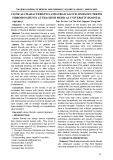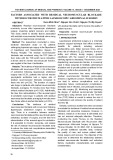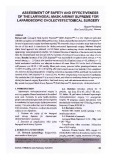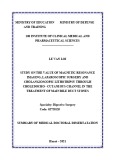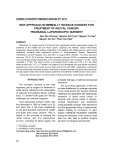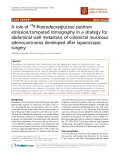
THAI BINH JOURNAL OF MEDICAL AND PHARMACY, VOLUME 14, ISSUE 5 - DECEMBER 2024
86
FACTORS ASSOCIATED WITH RESIDUAL NEUROMUSCULAR BLOCKADE
WITH ROCURONIUM AFTER LAPAROSCOPIC ABDOMINAL SURGERY
Doan Minh Nhut1*, Nguyen Van Chinh1, Nguyen Thi My Xuyen2
1. University of Medicine and Pharmacy at Ho Chi Minh City
2 Nguyen Tri Phuong Hospital
*Corresponding author: Doan Minh Nhut
Email: doanminhnhut@ump.edu.vn
Received date: 29/10/2024
Revised date: 11/12/2024
Accepted date: 17/12/2024
ABSTRACT
Objective: Residual neuromuscular blockade
commonly occurs after laparoscopic abdominal
surgery, impacting patient recovery and safety.
This study aimed to identify factors associated
with residual neuromuscular blockade when using
rocuronium in laparoscopic procedures.
Method: The researchers conducted a cross-
sectional descriptive study on 92 patients
undergoing laparoscopic surgery in the Department
of Anesthesia and Resuscitation, Nguyen Tri
Phuong Hospital. The residual neuromuscular
blockade was monitored using the TOF (train of
four) index with the TOF-watch nerve stimulator,
a device used to monitor neuromuscular function,
was applied at the time of extubation.
Results: The incidence of residual neuromuscular
blockade with rocuronium (TOF < 0.9) at the time
of extubation following laparoscopic abdominal
surgery was 53.3%, patients who did not receive
prophylactic antibiotics had a higher rate of
residual neuromuscular blockade compared to
those who did (p<0.05). The duration of surgery
was longer in patients with residual neuromuscular
blockade, averaging 10 minutes more than those
without residual blockade (p<0.0125). Additionally,
the time from administration of the reversal agent
to extubation was longer in patients with residual
neuromuscular blockade, averaging 4 minutes more
than those without residual blockade (p<0.015).
Conclusion: The incidence of residual
neuromuscular blockade with rocuronium following
laparoscopic abdominal surgery is relatively
high. There is a correlation between residual
neuromuscular blockade and the use of prophylactic
antibiotics, duration of surgery, and the time from
administration of the reversal agent to extubation.
It is essential to monitor, recognize, and assess
the risk of residual neuromuscular blockade early
to reduce the risks and complications associated
with residual blockade and to improve the quality of
patient recovery.
Keywords: residual neuromuscular blockade,
laparoscopic surgery
I. INTRODUCTION
Laparoscopic abdominal surgery is a minimally
invasive surgical technique that offers numerous
benefits for patients, including reduced
postoperative pain, faster recovery times, and a
lower risk of infection [1], [2]. However, to ensure
safety and efficacy during surgery, general
anesthesia with the support of neuromuscular
blocking agents is necessary. Rocuronium, a non-
depolarizing neuromuscular blocker, is commonly
used in these surgeries to facilitate endotracheal
intubation and to provide optimal conditions for the
surgeon to perform the procedure [3].
Although rocuronium has many advantages,
residual neuromuscular blockade post-surgery
remains a significant concern. Residual blockade
can lead to serious complications such as
respiratory failure, cardiovascular complications,
increased risk of infection, and prolonged recovery
time after surgery [4]. Monitoring and assessing
the degree of residual neuromuscular blockade
post-surgery using devices such as the Train-of-
Four (TOF) Watch is crucial to reduce the risk of
complications and enhance the quality of patient
recovery [5].
Globally, numerous studies have been conducted
to evaluate the incidence of residual neuromuscular
blockade and preventive measures. However, in
Vietnam, research on this issue is still limited and
has not received adequate attention. Therefore,
conducting the study “Survey on the Residual
Neuromuscular Blockade with Rocuronium after
Laparoscopic Abdominal Surgery at Nguyen Tri
Phuong Hospital, Ho Chi Minh City” is necessary
to provide additional scientific data, enhance
the quality of care, and ensure patient safety
during surgery and recovery. The objective of the
study was to determine the relationship between
residual neuromuscular blockade and individual
factors, medication characteristics and surgical
characteristics.





